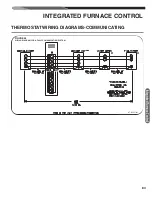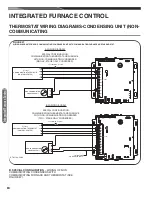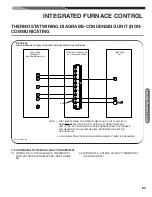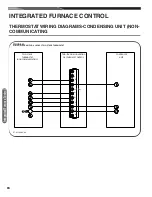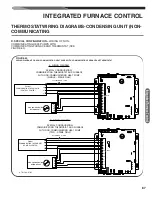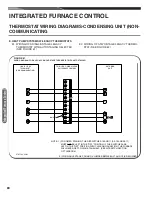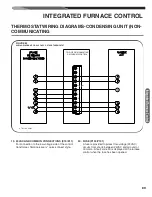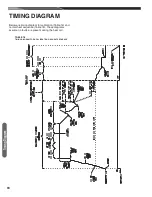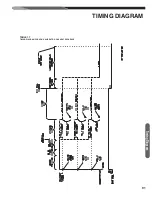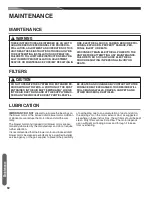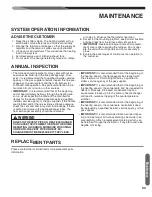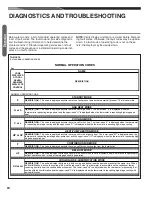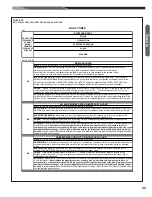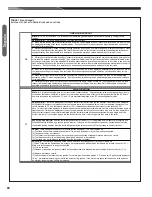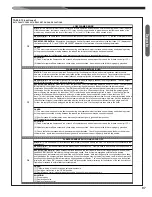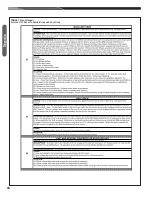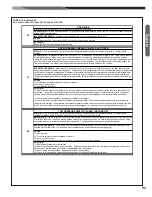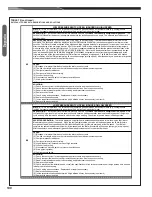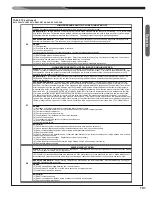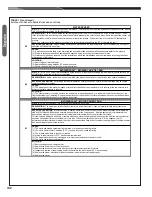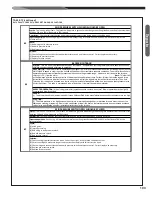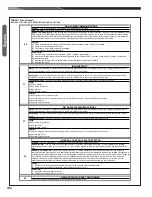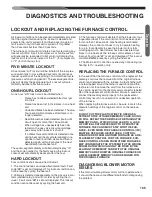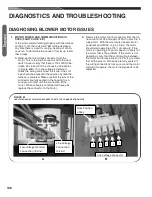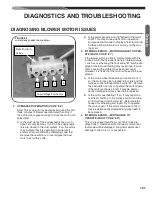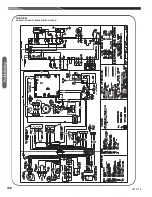
97
TABLE 19 (continued)
R97V FAULT CODES WITH DESCRIPTIONS AND SOLUTIONS
STATUS:
The status of this fault is non-critical and furnace operation will continue as normal in heating (and all other) mode(s).
If flame sense is low, the furnace control (or I.F.C.) may soon no longer be able to properly sense the flame and status of the
problem may be elevated to the level of fault code "
13
" or fault "
11
" (if flame can not be sensed at all).
12
DESCRIPTION:
The flame sense current from the flame sense rod at the furnace control (or I.F.C.) is weak or marginal at best.
(1) The most common cause for low flame sense during heat operation is that the flame sense rod may need cleaning or may
not be properly connected or wiring between the rod and the furnace control may be shorted or opened.
(2) Another cause for low flame may be an improperly mounted or poorly grounded flame sensor.
CAUSE:
(2) Reinstall or replace flame sensor and check wiring and connections. Also make sure the furnace is properly grounded.
(1) Clean or replace the flame sense rod or check all connections and wire between the rod and the furnace control (or I.F.C.).
SOLUTION:
SOLUTION:
(1) Clean or replace the flame sense rod or check all connections and wire between the rod and the furnace control (or I.F.C.).
(2) Reinstall or replace flame sensor and check wiring and connections. Also make sure the furnace is properly grounded.
(3) Check that all burner assembly components are properly installed. Check for good seals between the burner and blower
compartments. Insure that the combustion door gasket is in place and the door is properly installed and sealed.
(1) Wire properly.
(2) Replace gas valve.
14
FLAME PRESENT WITH GAS VALVE OFF
(2) Faulty gas valve stuck in the "OPEN" position.
CAUSE:
DESCRIPTION:
After a successful ignition trial, the flame (which
was
properly sensed) is no longer sensed. This can happen
any time after successful ignition while a valid heat call is present.
CAUSE:
EXPECTED OPERATION:
All operation (including gas heat) will proceed as normal with only the fault code ("
12
") displayed at
the furnace control (I.F.C.) and "
LO FLAME SENSE
" displayed in the fault area of a communicating thermostat.
LOW FLAME SENSE
EXPECTED OPERATION:
When flame is lost, the fault code ("
13
") is immediately displayed at the IFC SSD's. The IBM (Indoor
Blower Motor) is energized (if it was not already) at the correct speed (based on the demand from the thermostat) and
completes a 90 second blower off delay. The IDM (Induced Draft Motor) remains energized at the most recent speed (based on
the demand from the thermostat or as required for ignition cycle) for a 20 second post-purge. After both the post-purge and
blower off delay are complete, the fault code ("
13
") is removed and a new attempt at ignition is made. Often, the new ignition
attempt will fail and operation will proceed as though a failed ignition has occurred from that point (see fault code "
11
").
Note: This fault will not be displayed to the homeowner on communicating systems unless it occurs at least three times within a
single heat call. It will not be displayed to the homeowner after the first or even second failure. However, it will be displayed in
the active fault screen of thermostat immediately after the first failure (and all subsequent failures) during a single heat call.
Further, this fault (
13
) will only be logged into the fault buffer one time. It will not log more than once in the buffer.
(2) Another cause for low flame may be an improperly mounted or poorly grounded flame sensor.
(1) The most common cause for low flame sense during heat operation is that the flame sense rod may need cleaning or may
not be properly connected or wiring between the rod and the furnace control may be shorted or opened.
(3) Flame pattern may be unstable.
(3) Replace furnace control.
(3) Faulty furnace control (signal improperly sensed when it should not be sensed at all).
SOLUTION:
STATUS:
This is an extremely critical fault and should rarely (if ever) be seen in the field. The furnace will not operate with this
fault present.
DESCRIPTION:
This fault indicates flame is present when it should not be. Flame is seen to be present when the gas valve is
supposed to be off.
(1) Field mis-wiring of 24VAC to the gas valve main solenoid.
EXPECTED OPERATION:
When unexpected flame is sensed, the IBM (Indoor Blower Motor) is energized at maximum heat
speed and IDM (Induced Draft Motor) is energized at high speed. Both will remain energized until the fault is cleared.
Response to any thermostat call is not permitted until the fault is cleared. Note that the gas valve circuit should not have been
energized when the unexpected flame was sensed. When the condition causing the fault is cleared, the IDM will complete a 20
second post-purge and the IBM will complete a 90 second blower off-delay. The control will then enter a one-hour lockout and
display the fault codes "
10
" (one-hour lockout) and "
14
" (unexpected flame) alternately for the duration of the one-hour lockout.
Operation is returned to normal after the lockout period.
13
FLAME LOST AFTER ESTABLISHED
STATUS:
Flame loss is not a critical fault. Subsequent ignition attempts will follow and normal operation should resume.
However, a lost flame can often be followed by failed ignition attempts then a one-hour lockout. Once the status has reached
one-hour lockout, the fault condition is critical (although attempts at ignition will be made again after the 1 hour lockout).
Dia
gn
ost
ics

